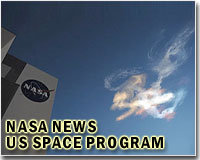 |
Washington DC (SPX) Jul 14, 2010 NASA announced three new Centennial Challenges Tuesday, with an overall prize purse of $5 million. NASA's Centennial Challenges are prize competitions for technological achievements by independent teams who work without government funding. "NASA sponsors prize competitions because the agency believes student teams, private companies of all sizes and citizen-inventors can provide creative solutions to problems of interest to NASA and the nation," said Bobby Braun, the agency's chief technologist. "Prize competitions are a proven way to foster technological competitiveness, new industries and innovation across America." The Nano-Satellite Launch Challenge is to place a small satellite into Earth orbit, twice in one week, with a prize of $2 million. The goals of this challenge are to stimulate innovations in low-cost launch technology and encourage creation of commercial nano-satellite delivery services. The Night Rover Challenge is to demonstrate a solar-powered exploration vehicle that can operate in darkness using its own stored energy. The prize purse is $1.5 million. The objective is to stimulate innovations in energy storage technologies of value in extreme space environments, such as the surface of the moon, or for electric vehicles and renewable energy systems on Earth. The Sample Return Robot Challenge is to demonstrate a robot that can locate and retrieve geologic samples from wide and varied terrain without human control. This challenge has a prize purse of $1.5 million. The objectives are to encourage innovations in automatic navigation and robotic manipulator technologies. Centennial Challenges are extended to individuals, groups and companies working outside the traditional aerospace industry. Unlike most contracts or grants, awards only are made after solutions are successfully demonstrated. NASA is soliciting proposals from non-profit organizations to manage each of the three new competitions. Centennial Challenge events typically include public audiences and are televised or broadcast over the Internet via streaming video. The competitions provide high-visibility opportunities for public outreach and education. After the partner organizations are signed, NASA and those organizations expect to announce challenge rules and details on how teams may enter later this year. Proposals from organizations interested in partnering with NASA are due by Sept. 13. Selection of partner organizations is expected by Oct. 8. Since 2005, NASA has conducted 19 competition events in six challenge areas and awarded $4.5 million to 13 different teams. There are three current Centennial Challenges: + The Strong Tether Challenge: Teams must demonstrate a material that is at least 50 percent stronger than the strongest commercially available. The challenge is scheduled for Aug. 13 in Seattle. + The Power Beaming Challenge: Teams must transmit power using laser beams to a device, so it can climb a vertical cable more than half a mile high. The challenge is planned for the fall of 2010. + The Green Flight Challenge: Teams will fly aircraft they designed to travel 200 miles in less than two hours using the energy equivalent of less than one gallon of gasoline per occupant. The challenge will be held in July 2011. It is expected to attract electric, hybrid and bio-fueled aircraft.
Share This Article With Planet Earth
Related Links Centennial Challenges at NASA Space Tourism, Space Transport and Space Exploration News
 New U.S. space policy sets global agenda
New U.S. space policy sets global agendaWashington (UPI) Jun 29, 2010 Advanced science and technology industries worldwide will have new opportunities in an overarching space policy unveiled by President Barack Obama as part of his strategy to boost investment and speed economic recovery. The policy precedes an anticipated end of the space shuttle program this year and exploration of closer U.S.-Russian collaboration, including American use of the Russian ... read more |
|
| The content herein, unless otherwise known to be public domain, are Copyright 1995-2010 - SpaceDaily. AFP and UPI Wire Stories are copyright Agence France-Presse and United Press International. ESA Portal Reports are copyright European Space Agency. All NASA sourced material is public domain. Additional copyrights may apply in whole or part to other bona fide parties. Advertising does not imply endorsement,agreement or approval of any opinions, statements or information provided by SpaceDaily on any Web page published or hosted by SpaceDaily. Privacy Statement |